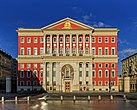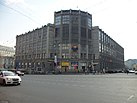Tverskaya Street
|
Clockwise from top: View on State Historical Museum, Hotel National, The Carlton Moscow, Central Telegraph building, Moscow Mayor's office | |
| Native name | Тверская улица (Russian) |
|---|---|
| Length | 1.6 km (0.99 mi) |
| Location | Moscow, Russia Central Administrative Okrug Tverskoy District |
| Postal code | 125009, 125032, 127006 |
| Nearest metro station | |


Tverskaya Street (Russian: Тверская улица, IPA:
History and architecture
Middle Ages to 18th century
Tourists are told that Tverskaya Street existed as early as the 12th century. Its importance for the medieval city was immense, as it connected Moscow with its superior, and later chief rival,
In the 17th and 18th centuries, Tverskaya Street was renowned as the centre of Moscow's social life. The nobility considered it fashionable to settle in this district. Among the
During the imperial period, the importance of the thoroughfare was highlighted by the fact that it was through this street that the tsars arrived from the Northern capital to stay at their Kremlin residence. Several
19th century

During
The columns of the city gate
Gleam white; the sleigh, more swift than steady,
Bumps down Tverskaya Street already.
Past sentry-boxes now they dash,
Past shops and lamp-posts, serfs who lash
Their nags, huts, mansions, monasteries,
Parks, pharmacies, Bukharans, guards,
Fat merchants, Cossacks, boulevards,
Old women, boys with cheeks like cherries,
Lions on gates with great stone jaws,
And crosses black with flocks of daws.
Towards the end of the 19th century, the street was reconstructed, with stately neoclassical mansions giving way to grandiose commercial buildings in an eclectic mixture of historical styles. A characteristic edifice of the time is the
Modern history

Between the
Further expansion occurred in line with
The project was only partially completed before
When Soviet President Mikhail Gorbachev assumed power, he encouraged a return to the country's old Russian names. Thus, the street's name became "Tverskaya Street" again, after a 55-year interlude as Gorky Street.[4]
Layout and functions
Tverskaya Street runs from the
Tverskaya Street is the most expensive shopping street in Moscow and Russia. According to an index published by global real estate company Colliers International in 2008, it is now the third most expensive street in the world, based on commercial rental fees. It is the center of the city's
Reconstruction plan, 2007-2009
This article needs to be updated. (November 2019) |
Plans for the reconstruction of the Tverskaya radius into a grade-separated freeway, already under way in remote parts of the route (see
See also
- List of upscale shopping districts
References
- ^ Gruliow, L.: Moscow. Time Life Books, 1978.
- ^ Benedetti (1999, 27).
- ^ Benedetti (1999, 42).
- ^ a b Parks, Michael. "Gorky Street Loses Name as Muscovites Reach for Past", Los Angeles Times (July 29, 1990).
Sources
- Benedetti, Jean. 1999. Stanislavski: His Life and Art. Revised edition. Original edition published in 1988. London: Methuen. ISBN 0-413-52520-1.





